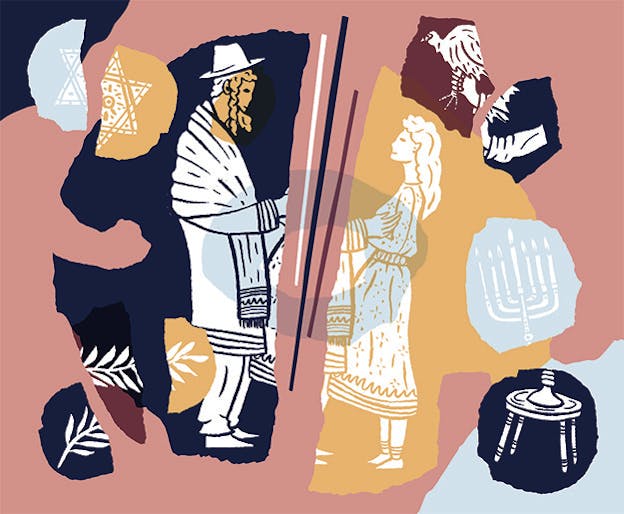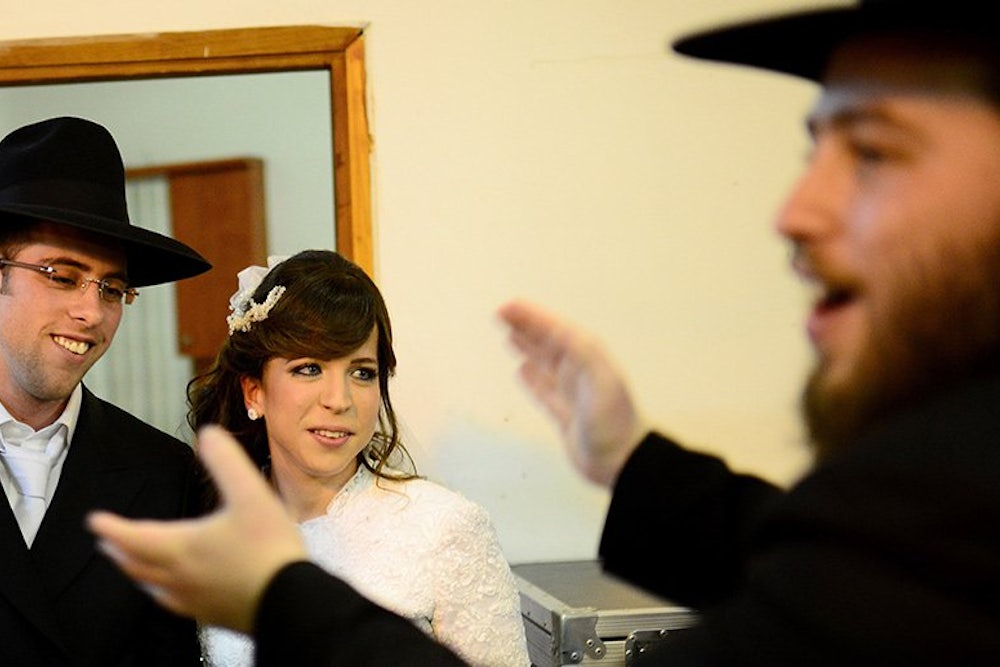Every day (except Saturday) five middle-aged women gather in the basement office of a brick building in Brooklyn’s Borough Park neighborhood to assure the survival of ultra-Orthodox Judaism. Black-hatted men and “modestly” dressed women come to them, some young, others less so, all single. These women, professional shadchanim, or matchmakers, ask the men and women about their family connections and education, who they know, where they pray. Careful attention is devoted to the shidduch (matchmaking) résumé, a short document that includes most of these details plus a photo and references.
The shadchanim dismiss their unmarried charges after the interviews, then huddle together in a dark room lined with ancient religious texts. Speaking in a mixture of English, Yiddish, and Hebrew, they rifle through their notes, searching for matches. They are helping the men and women—especially the women—fulfill the primary social responsibility of their community: to get married.
For the ultra-Orthodox, religious restrictions against the “mingling” of genders prevent singles from taking advantage of contemporary coupling opportunities. There are no dating websites, apps, or events. Marital aspirants meet almost exclusively through the intercession of shadchanim like this group in Borough Park. A matchmaker—usually a woman, but men provide the service as well—finds a match and informs the parents on each side. The parents then conduct “research” into the proposed spouse. They ask around about the other family’s connections, check to see if there are any divorces, or if any of the proposed relations have abandoned the community in favor of the secular world. If all goes well, the matchmaker makes an introduction.
One chilly afternoon this fall, I met with one of the five Borough Park matchmakers—let’s call her Raisy—in her basement sanctum. Raisy was a plump woman with bright blue eyes visible through the bangs of the sandy-colored wig she wears per Orthodox tradition. She sat behind a desk cluttered with spiral notebooks, stacks of dating questionnaires, and an old desktop computer that contained her database of single ultra-Orthodox Jews. Raisy was initially reluctant to talk to me—Orthodox communities tend to be wary of outsiders, and a good shadchan should be discreet—but the difficulties of her job eventually began to tumble out. The holy work of matchmaking, she said, had become so much harder of late.

She was referring to the so-called Shidduch Crisis that has in recent years caused a panic throughout Orthodox and ultra-Orthodox Jewish enclaves in New York and New Jersey. The crisis stems from two factors: the rapid growth of the ultra-Orthodox and the marriage-age differential between men and women in their communities. Ultra-Orthodox women are ready to marry typically by age 19, after a post-high-school year in seminary; the men continue their religious studies into their early twenties. That scenario, plus the rapid growth of these communities—an estimated 3 percent per year—means more 19-year-old women than 23-year-old men. The result: Some women in every cohort pass unwed through their conventional prime marrying years. This marital imbalance has been exacerbated by the overall growth of the community. Put simply, there are too many unmarried women. (Among Hasidic Jews, men and women generally marry at the same age, so this problem has not affected them.)
The matchmaking crisis dominates the Friday night discussions at today’s ultra-Orthodox Shabbat tables. Last year, Ami magazine, an Orthodox glossy, referred to unmarried women as a ticking “time bomb.” Mishpacha, a family magazine, ran a lengthy feature in August on the subject—Title: “Crisis Control”—in which they called single ultra-Orthodox women a demographic cancer “that is metastasizing.” Shlomo Yehuda Rechnitz, a wealthy Orthodox businessman, went further, writing in Mishpacha that he would guarantee $10,000 to any matchmaker able to place a woman 25 or older with a man the same age or younger. An op-ed in The Jewish Press suggested that female singles should consider surgical enhancements, like a nose job. To the mother of these women, the author added: “Borrow the money if you have to; it’s an investment in your daughter’s future, her life.”
It is important to note that actual evidence of a crisis can be hard to find. Because of the insularity of these communities, no formal research into the issue has been conducted. One anecdotal study, however, done about ten years ago in Lakewood, New Jersey, predicted that for every 1,500 frum young women, approximately 150 were doomed to not marry. These seem hardly disastrous rates. The study, conducted by a rabbi and an insurance analyst, may have employed questionable research methods.
But even if the problem may not exist, the hand-wringing over it certainly does. “Who in their wildest dreams can begin to describe the tzaar, the stabbing pain, that our precious bnos Yisrael [Daughters of Israel] endure,” Rechnitz wrote in Mishpacha. “Single forever! No husband, no children … ever! Is this a life worth living?’”
The paramount importance of marriage in these communities cannot be overstated. “In the secular world the individual is the node. In their world, the individual doesn’t quite matter as much,” said Samuel Heilman, a sociology professor at Queens College whose work focuses on the social ethnography of contemporary Orthodox Jewish movements. “It’s all about communal ties. For the men, it’s about shul. For the women, it’s about school, the children, other mothers. If she’s not a mother, she’s nobody.”
Single women have no role in the organized life of this very communal religion. “Basically, from the perspective of the community, they don’t really exist,” said Yossi Krausz, an Orthodox journalist for Ami.
The shidduch crisis has changed these communities in powerful ways. Forms of individuation or societal rule-bending that might have been permitted in the past have all but disappeared.
“Gray areas became black,” one ultra-Orthodox woman from Chicago told me. “No one will have mixed seating at a wedding anymore, even though there’s nothing [religiously] wrong with it. No one goes to the movies anymore.” Acting out isn’t worth it if it might cost you—or a sibling, a cousin, or a child—a match. Strict conformity and a sense of being observed and judged has become par for the dating course.
More stark, although perhaps inevitable, is how the crisis empowers the already powerful. “The men have gotten pickier,” said one male matchmaker, who didn’t want his named used (“I have kids to marry off”). The unavailability of men has shifted the bargaining power in their favor. “Girls became less desirable, and the boys more desirable, and now a boy can marry anyone,” the matchmaker said.
Matchmakers have not always responded to the crisis with equanimity. Dena, a 31-year-old teacher from New York, told me about one matchmaker who was unable to find her a date. (Dena is not her real name—she feared reprisals from men and matchmakers alike). When she asked why men kept rejecting her, the matchmaker replied, “Maybe you should go to the gym a little bit more.”
Sharon, an Orthodox 40-year-old from the Midwest (also not her real name), told me that another matchmaker insisted they become Facebook friends, and then went through her online photos, deleting ones she didn’t like. “She looked at each one and said, ‘No! Not photogenic! I don’t want to see that picture.’”
Aliza, 31, described an almost factory-like approach by some shadchanim. She recalls going to an event with another panel of matchmakers in Brooklyn. “They each had their own method,” she said. “One had a binder, one has notecards, one has a computer. And while you’re talking, they’re flipping through their lists of guys.” The matchmakers asked for information on men she’d dated previously and for the names of married men she found attractive. They jotted down everything she had to say, but the grilling yielded no introductions. Married now, she met her husband on her own.
One solution to the crisis, of course, would be to ask ultra-Orthodox men to marry younger, or to marry women of the same age or older. But in a society that values tradition, there remains little incentive for young men to change.
Even fake crises can have real consequences. Assimilation is the great fear of Orthodox Jews: the loss of their young, and ultimately their identity, to the wider secular society. And yet it is these unmarried, and in some ways unwanted, women who pose the greatest risk to flee this world for another.
“When a woman sees no future for herself in the community,” Krausz told me, “the logical step is to leave.”
